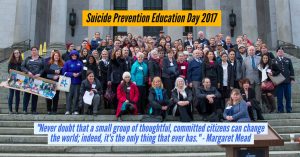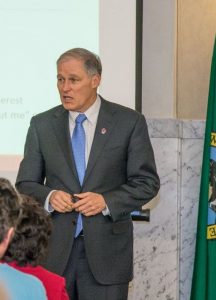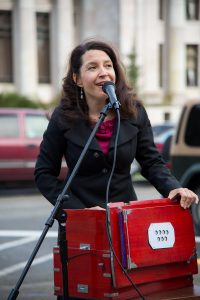Suicide Prevention Education Day amplifies hope in Olympia
It was a day that shouted hope: On Feb. 16, over 100 converged in Olympia for Suicide Prevention Education Day – for the third year in a row since Forefront’s inaugural Education Day in 2014. Constituents from 48 districts scurried through the Capitol campus to meet with legislators. For the second year in a row, the Suicide-Safer Homes Memorial’s color-coded headstones represented the toll of suicide loss in this state – 1,129 deaths in 2015.
Every year, the numbers change – but never the mission.
Co-sponsored by the Washington Department of Veteran Affairs and Crisis Clinic, Education Day began at the Women’s Club of Olympia. A luncheon at the Governor’s Mansion and Ceremony of Remembrance and Hope featured speakers sharing stories of loss, hope, stigma, and surviving attempts.
“Tons of bills go through Olympia every day. Legislators need to become aware of these bills going through their committee,” said Forefront faculty director and co-founder Jennifer Stuber at an advocacy orientation that morning. “Many of your legislators may also have been impacted by suicide. Encourage them to tell their story too.”
Over 1,000 bills have already been introduced into the Legislature in this session.

Thus it is critical to get suicide prevention-related measures on top of lawmakers’ minds: HB 1379 (comprehensive suicide prevention initiatives in higher education), HB 1612 (creating a public-private fund to continue the work of the Suicide-Safer Homes Task Force), and HB 1047 (a drug take-back bill). All except HB 1379 have been scheduled for a public hearing at the House Appropriations Committee this week.These bills need to clear an extra hurdle this year: The Legislature is grappling with the McCleary ruling to increase funding for basic public education by the year 2018. This has led Forefront and its allies to seek ways of doing the work with less state funding.
For suicide prevention champion Rep. Tina Orwall (33rd district) and lawmakers like Rep. Brian Blake (19th district), backing these bills is a no-brainer. Other legislative champions are becoming increasingly vocal: “(Suicide) has become a top issue for me,” said Senator Steve O’Ban (28th District), speaking at the ceremony. “This is a bigger issue than many legislators want to admit.”
Weeklong suicide awareness at the Capitol

To raise suicide prevention awareness in the week of Education Day, Olympia was the site of weeklong events and points of interest.
- On Feb. 12, fifteen loss survivors installed the second annual Suicide-Safer Homes Memorial – a display on the Capitol lawn which attracted passersby curious about the color-coded headstones, and astonished that the numbers reflect not ten, not five, but one year of suicides.
- On Feb. 13, Forefront played host to a L.E.A.R.N. suicide prevention training for members of the Executive Cabinet. In an intimate Columbia Room setting, presenter Stephen Paul Miller led about 70 guests through role-play sessions. Gov. Jay Inslee made an appearance, making brief remarks about his support of public-private funding for Suicide-Safer Homes (HB 1612) and the importance of access to health insurance.
- On Feb. 15, advocates – including the NRA, UW School of Dentistry, and Washington Alliance for Gun Responsibility – gave testimonies to the House Judiciary Committee to support HB 1612.
Strong military representation
For the first time, the Memorial included 22 pairs of military boots to accompany the 225 yellow ribbons that symbolize suicide by a veteran.
One veteran lost to suicide was Greg Lewis, a Navy lieutenant and medic who served with Special Force teams.
His widow, Jo Arlow, gave a tribute to the “funny, intelligent, and loving Renaissance Man” who made 50 bids (nearly half of them successful) for a Mt. Rainier summit. His life was marked by stress, disability, and PTSD prior to his suicide in 2011.
“Peer to peer support” was critical to healing, Arlow said. Giving a shout-out to the Washington State Department of Veterans Affairs and U.S. Sen. Patty Murray, she encouraged the audience to get to know veteran-oriented organizations such as Mission Continues, Team Red, White, and Blue, and Save a Warrior.
Michael Ramires, another Navy veteran, came to a head with a PTSD diagnosis two years ago: “I just wanted the pain to stop. I started to make a plan to make the pain end immediately.”
His story culminated in a message of hope and collaboration: “I decided to keep the gun at home, but locked. I didn’t have a key. My therapist and wife helped me to see that this was my best option.”
This highlights a provision of the Suicide-Safer Homes Bill: To make it legal to temporarily transfer firearms from a gun owner struggling with suicidal ideation, to a trusted family member or friend.
Education Day also featured a L.E.A.R.N suicide prevention training by Ahmad Bennett, a Navy veteran who survived a suicide attempt and told us about warning signs: “I’d say things like ‘I can’t wait until this is over with’. I was speaking in code.”
Record numbers of newcomers send message of hope and recovery

Over 60 percent of Suicide Prevention Education Day registrants had never attended a Forefront event before – signaling a sea change in a subject that has been clouded by stigma.
Cal Beyer, a risk management director for Lakeside Industries, spoke at the Governor’s Mansion about losing a friend (also a construction colleague) to suicide several years ago.
“I want to break the stigma in my industry. It’s really important to get people back to work safely. (Lakeside Industries) is committed to building an internal network with peer to peer support,” he said.
In 2016, the CDC published a report showing that the construction industry has the second highest rate of suicide. With suicide being a leading cause of death in the age 10-24 group, young adult speakers also provided a poignant perspective.
From Western Washington University, student Mary Richards stood near her parents as she described rebounding from a suicide attempt with their support (“I finally see a future for myself”); and Ian Vincent, a loss survivor and Men’s Resiliency Specialist, said: “I can’t bring my friends back to life, but I can help prevent others from taking their own lives.”
Co-sponsors, allies drive long-haul public health message
Suicide prevention drew analogies to earlier public health concerns:
“In 1979 … everyone knew someone who struck by polio. The numbers today are 99.9% reduced,” said Peter Schmidt, PTSD director of the Washington Department of Veteran Affairs, an Education Day co-sponsor. “Now let’s talk about suicide. Here’s a challenge for us all: Changing our beliefs that suicide can drop to zero.”
“Joining with a unified voice is half the battle. But the other half is also to hear,” said Micheal Reading, director of crisis services for Education Day co-sponsor King County Crisis Clinic. “If we’re talking, we also need to listen.”
The National Suicide Prevention Lifeline – to which the Crisis Clinic belongs – answered 1.5 million phone calls last year.
Washington Secretary of Health John Wiesman likened suicide prevention to his first job of addressing early HIV as a public health issue. Urging citizens to get involved with the statewide suicide plan, he said: “You don’t need a degree, or a specific job – you just need passion.”
What’s next?
Click here to watch the HB 1612 testimonies, and go to the Legislature’s Bill Information page to track the bills’ progress through the House and Senate. This page shows how to contact your senators and representatives.